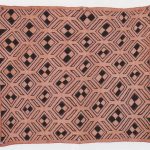Cheryl Kolak Dudek, Margarita Lypiridou, Nasim Sedaghat, Sudhir Mudur, Fred Szabo, Lydia Shaman, Thomas Fevens: African Kuba Textiles
Artist(s):
- Cheryl Kolak Dudek
- Margarita Lypiridou
- Nasim Sedaghat
- Sudhir P. Mudur
- Fred Szabo
- Lydia Shaman
- Thomas Fevens
Title:
- African Kuba Textiles
Exhibition:
- SIGGRAPH 2008: Design and Computation
-
More artworks from SIGGRAPH 2008:


Creation Year:
- 2008
Category:
Artist Statement:
African Kuba Textiles: Structural Inference and Contemporary Design Using Shape Grammars
While many cultures create designs with geometric patterns, each has distinct motifs and symmetries. The textiles by the Kuba ethnic groups in southeastern Congo are unique in their iterations and transformations of basic geometric shapes. These textiles, woven from the fiber of the raphia palm, reveal a sophisticated vocabulary of geometric patterns. This project illustrates application of a generative model to interpret the geometric structure inherent in Kuba textiles by ascribing a shape grammar, to create contemporary design variations through grammar variations, and finally to fabricate the new designs on a computerized loom.
Kuba textile designs can be described as compositions of simultaneous diversity. Women artisans incorporate spontaneity and improvisation in their designs to achieve uniqueness and individuality – part of their cultural aesthetics. The designs are most often characterized by semi-symmetry, achieved by the juxtaposition of distinct geometric motifs, and by controlled variations in texture, scale, shape, orientation, and/or color. As the knowledge and skills of elder generations die out, analysis of these art forms generates considerable interest in the contemporary design and arts community.
Shape grammars provide a powerful paradigm both for representing the structural complexity in existing designs, like Kuba, and for creating contemporary variations. They also provide a structured mechanism to express the recursion inherent in the artwork. Arrangements are formally captured as a finite sequence of Euclidean transformations (translation, rotation, scale, and reflection). Coloring techniques in the artwork are expressed as properties of basic shapes. Texturing, blending, and fading are employed as the primary coloring techniques.
By traversing the grammar’s language or reworking grammars, artists, designers, and historians can wander freely in the “neighborhood” of an existing design, exploring variations and discovering elements that define the character of an existing pattern. By modifying a pattern to replicate another existing design, the artist or researcher can get a hands-on feel for the similarities and differences between them. The end product of such work may be new patterns or simply a better understanding of the ones under examination.
It is possible to generate interesting families of artworks by simple variations in their grammar rules. A child grammar may even retain the exact pictorial specification, but modifying coloring rules may yield a new design through different blending, line traits, or color assignments.
Once new designs are specified using modified shape grammars, pictorial specifications can be used to drive a computerized Jacquard loom and fabricate new designs.
Other Information:
Acknowledgements
This work is supported by grants from the Science and Engineering Research Council, Canada Discovery grant programme, Fonds Quebecois de la recherché sur la société et la culture, Appui à la recherché creation programme, the Social Sciences and Health Research Council, Canada Research/Creation in Fine Arts Programme, Hexagram, and Concordia University Faculty Research grants. We also gratefully acknowledge the deep involvement of our former graduate research students on this project: E. Hortop, D. El-Khechen, R. Rajagopalan, and Y. Joshi.






